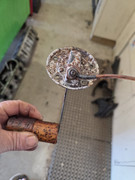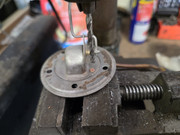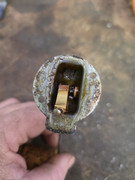Between work today I was able to sneak in a little effort on the ute.
I wanted to prep te fuel tank to be sealed with POR 15, but when I went to pull out the fuel sender yesterday I found it had been sealed in with what looked like JB Weld. It was certainly harder than body filler and was grey in colour. My plan was to clean the tank to prevent a vapour explosion from sparks and then grind out the JB Weld with a an angle grinder and the dremmel. When I took it outside in the sun to start this I noticed one edge looke like it was lifting so I grabbed a cold chisel and a hammer and took to it as an experiment. It started to flake off in small chunks so I kept going and half and hour later I had exposed the cap over the sender unit and with a bit of effort I was able to pry it out. The "sealant" material did not stick to the tank itself but was bonded to the sender cover. I was able to get if off with a bit of effort on the wire wheel. I can only imagine that the fuel sender was leaking so it was sealed in.
I removed the sender unit - it was stuck solid in the empty postion. The tank insides are heavily varnished so it will take a bit of work to prep it for the POR. I put the tank aside and focussed my effort on the sender unit.

First job was to blast the crud off the outside - took a couple of minutes to do and it looked good I drilled out the rivets and separated the rheostat from the moving contact.

The internals were covered in varnish and stuck solid. I could not get any movement.

Not wanting to break anything I decided to stick the float and contact into some fresh fuel to "melt" the varnish. I cut off the float so it would fit in a small jar and soaked it for a while - no luck with that.
I had the twin carbies lined up to go into the untrasonic cleaner so I hit the added some more fuel to the glass jar and stuck that in with the hot water and finish dishwashing tablets amd let the untrasonic cleaner do its thing.
The fuel sender parts came out clean on the outside but still had varnish on the inside - but the varnish just flaked off when touched - so a couple so minutes with a pick and small falt screwdriver and the interior was clean.
The heat and vibrations had softened up the fuel varnish so I was bale to slowly get the float arm to move and finally with a few more dips in the warm fuel and a bit of carby cleaner spray the movement freed up. A quick check for continuity and then resistance readings 0.2 ohms at empty and 33 ohms at full and we had enough to make a functioning fuel sender.
So I used the MIG to weld the float arm back on and we were good to go. Hand assembled and tested it could get the full range of movement and had 0 ohms at empty and 32 ohms at full. Close enough for me so now it is a matter of finding some brass rivets of the right size and we have saved about 180 beer tokens.
As for the carbies - came out clean - still need to go over them.





 Did you end up ordering one of these ? We just got back from the FB/EK Nationals and after driving for a smidgen over 7000km a steering wheel cover would be a nice to have ......
Did you end up ordering one of these ? We just got back from the FB/EK Nationals and after driving for a smidgen over 7000km a steering wheel cover would be a nice to have ...... 